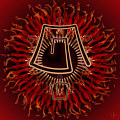|
Picture Books are an important aspect of children's literature. Illustrated portrayal of text is as old as literature, but specifically in material written for developing readers, the use of illustration to aid in deciphering words and concepts is all the more important. Picture books are an important element in the development of basic readers. "Thanks to a more affluent Society, to increased awareness of the rewards of childhood, to courses in children's literature and its critical valuation, and very importantly to the growing significance of awards [given] to children's books... children seem to be continuously blessed with well illustrated literature" (Lukens 39) . The pictures add to and embellish story, impacting the reader immediately, while the text underlines, defines and fleshes out the specifics of the story. Literary critic Joseph Schwarcz observes that the reader assimilates text a morsel at a time, synthesizing as new material is added to the broader understanding of the work. Pictorials, conversely, impact the reader at once, the broad story being told immediately, and the details fleshed out as the eyes move around the work to dissect the work into its smaller parts (Qtd in Lukens 40). The combination of the two is a powerful combination, and while it forces the brain into a complex function, the intricacy of the work is part of its longevity, especially for children who are inclined to want to enjoy the same work over and over. Upon subsequent readings, new details seem to arise, keeping the work fresh. Various art forms can be used in picture books, from photographs and montages to drawings and paintings. Illustrations can have a profound effect on the reader's perception of the work, including its tone as well as character identification. For example, the dramatic rendering of Chris Van Allsburg's The Polar Express matches the magical nature of a tale that involves a well-established well-respected character. The richness and scale of the illustrations match the child's preconceived idea of a realistic Santa Claus. Conversely, the nonsensical world of Dr. Seuss is punctuated by a more cartoonish drawing style, which emphasizes both the humor in the text as well as the illustrations of the stories and lessons. The characters are inventions of the author, rather than preconceived ideas, and can be as fantastical, outlandish and comic as the author wishes. This differentiation creates different cause-and-effect relationships between text and imagery. In essence, fantasy works like "The Polar Express" have engaged their audience with a well-known subject matter and the pictures embellish the story. For work like that of Dr. Seuss, the educational nature of books relies on the illustration to grab the reader's attention, engage them in the lesson, and help them to grasp the concepts to be learned within the book. Neither approach diminishes the illustrations or the text. Names: Theodore Geisel (Dr. Seuss) Maurice Sendak Lukens, Rebecca J. Picture Books.A Critical Handbook of Children's Literature. Boston: Pearson, 2007. © T. T. Eiland, August, 2006 |
